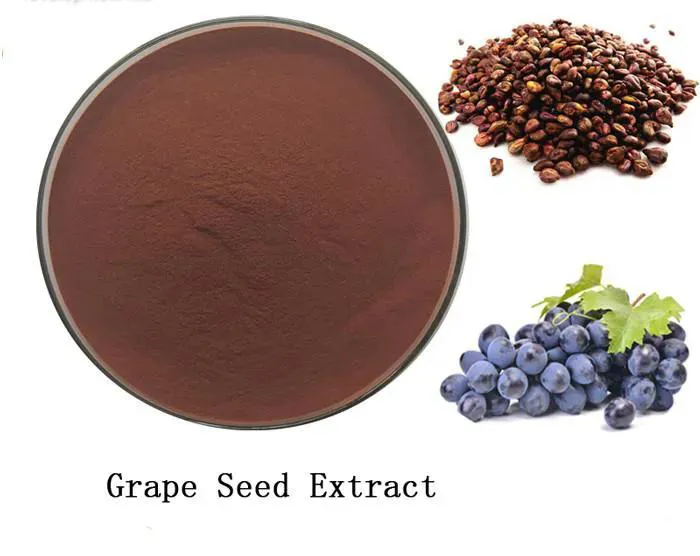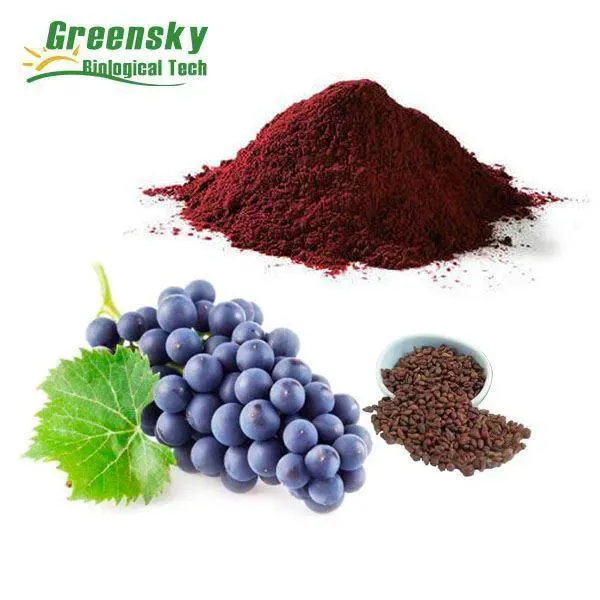- 0086-571-85302990
- sales@greenskybio.com
Harnessing Grape Seed Extract for Targeted Apoptosis in Cancer Therapy
2024-08-16

1. Introduction to Apoptosis in Cancer and Targeted Therapies
Cancer remains one of the most significant health challenges globally. Apoptosis, a form of programmed cell death, plays a crucial role in maintaining the balance of cell growth and death in normal tissues. In cancer, this balance is disrupted, with abnormal cells evading apoptosis and proliferating uncontrollably.
Traditional cancer treatments such as chemotherapy and radiotherapy often lack specificity, affecting both cancerous and normal cells. This non - specificity leads to various side effects. Targeted therapies have emerged as a more refined approach, aiming to specifically induce apoptosis in cancer cells while sparing normal cells.

2. Grape Seed Extract (GSE) as a Potential Candidate
Grape Seed Extract (GSE) has gained increasing attention in recent years as a potential agent for cancer therapy. GSE is rich in polyphenols, including proanthocyanidins, flavonoids, and phenolic acids. These bioactive compounds are believed to be responsible for its potential anti - cancer properties.
GSE is obtained from grape seeds, which are a by - product of the winemaking industry. It can be easily extracted and processed into various forms for research and potential therapeutic applications.

3. Chemical Composition of GSE Contributing to Apoptotic Properties
3.1 Proanthocyanidins
Proanthocyanidins are a major component of GSE. These large molecules are known for their antioxidant properties. In the context of cancer, they can modulate intracellular signaling pathways related to apoptosis. For example, they may interfere with the activation of anti - apoptotic proteins and promote the activation of pro - apoptotic proteins.
3.2 Flavonoids
Flavonoids in GSE also play a significant role in its apoptotic effects. They can interact with cell membranes and receptors, triggering a cascade of intracellular events. Some flavonoids have been shown to increase the production of reactive oxygen species (ROS) in cancer cells. Elevated ROS levels can lead to DNA damage and subsequent activation of apoptotic pathways.
3.3 Phenolic Acids
Phenolic acids present in GSE contribute to its overall anti - cancer activity. They can inhibit the growth and survival of cancer cells by affecting various cellular processes. For instance, they may disrupt the cell cycle progression of cancer cells, forcing them to enter apoptosis.

4. Synergistic Effects of GSE when Combined with Other Anti - Cancer Agents
One of the most promising aspects of GSE is its potential to act synergistically with other anti - cancer agents.
- When combined with chemotherapy drugs, GSE may enhance their cytotoxic effects on cancer cells. For example, in some pre - clinical studies, GSE has been shown to increase the sensitivity of cancer cells to drugs like cisplatin. This synergy could potentially allow for the use of lower doses of chemotherapy drugs, thereby reducing their side effects.
- In combination with radiotherapy, GSE may improve the therapeutic outcome. It could help radiosensitize cancer cells, making them more vulnerable to radiation - induced damage. This is thought to be due to GSE's ability to interfere with DNA repair mechanisms in cancer cells, preventing them from recovering from radiation - induced DNA breaks.

5. Review of Current Research on GSE - Induced Apoptosis in Different Cancer Cell Lines
Research on GSE - induced apoptosis has been conducted in a variety of cancer cell lines, providing valuable insights into its specificity and effectiveness.
5.1 Breast Cancer Cell Lines
In breast cancer cell lines, such as MCF - 7 and MDA - MB - 231, GSE has been shown to induce apoptosis. The apoptotic effects are associated with changes in the expression of key apoptotic proteins, such as an increase in Bax (a pro - apoptotic protein) and a decrease in Bcl - 2 (an anti - apoptotic protein). These changes lead to the activation of caspases, which are the executioners of apoptosis.
5.2 Prostate Cancer Cell Lines
Studies on prostate cancer cell lines like LNCaP and PC - 3 have also demonstrated GSE - induced apoptosis. GSE appears to target specific signaling pathways in these cells, such as the androgen receptor signaling pathway. By interfering with this pathway, GSE can disrupt the growth and survival signals of prostate cancer cells, ultimately leading to apoptosis.
5.3 Colorectal Cancer Cell Lines
For colorectal cancer cell lines, including HT - 29 and SW480, GSE - induced apoptosis has been observed. The apoptotic process in these cells is often accompanied by alterations in cell cycle regulation. GSE can arrest the cell cycle at specific phases, such as G1 or G2/M, preventing the cells from dividing and eventually triggering apoptosis.
6. Safety and Regulatory Aspects Associated with the Use of GSE in Cancer Therapy
Before GSE can be widely used in cancer therapy, its safety and regulatory aspects need to be carefully considered.
6.1 Safety Profile
Generally, GSE has been considered relatively safe in pre - clinical and some clinical studies. However, like any bioactive substance, it may have potential side effects at high doses. Some reports have suggested that high - dose GSE may cause gastrointestinal discomfort, such as nausea and diarrhea. Additionally, there may be concerns regarding its long - term safety, especially when used in combination with other drugs.
6.2 Regulatory Considerations
The regulatory status of GSE in cancer therapy varies across different countries. In some regions, it is classified as a dietary supplement, while in others, more stringent regulations may apply for its use in therapeutic applications. The lack of standardized manufacturing processes and quality control measures for GSE products also poses a challenge. To ensure its safe and effective use in cancer therapy, there is a need for more comprehensive research, standardization of production, and clear regulatory guidelines.
7. Conclusion
Grape Seed Extract (GSE) shows great potential as a targeted agent for inducing apoptosis in cancer therapy. Its chemical composition, including proanthocyanidins, flavonoids, and phenolic acids, contributes to its apoptotic properties. The synergistic effects with other anti - cancer agents further enhance its therapeutic potential. Current research on GSE - induced apoptosis in different cancer cell lines has demonstrated its specificity and effectiveness. However, safety and regulatory aspects need to be addressed before it can be fully integrated into cancer treatment regimens. Future research should focus on further elucidating the mechanisms of GSE - induced apoptosis, optimizing its combination with other therapies, and ensuring its safety and quality for clinical use.
FAQ:
What is apoptosis in the context of cancer?
Apoptosis in cancer refers to the programmed cell death process. In normal cells, apoptosis helps maintain tissue homeostasis by eliminating damaged or unwanted cells. In cancer, apoptosis is dysregulated, and cancer cells often evade this normal cell - death mechanism. This allows them to survive and proliferate uncontrollably. Targeted cancer therapies aim to re - activate the apoptotic pathway in cancer cells to induce their death.
What makes grape seed extract a potential candidate for targeted apoptosis in cancer therapy?
Grape seed extract (GSE) is a potential candidate due to its chemical composition. It contains various bioactive compounds such as proanthocyanidins. These compounds have antioxidant, anti - inflammatory, and anti - proliferative properties. They can interact with cellular pathways involved in apoptosis, such as modulating the expression of proteins that regulate cell death, thus making GSE a promising agent for targeted apoptosis in cancer therapy.
How do the synergistic effects of GSE with other anti - cancer agents work?
When GSE is combined with other anti - cancer agents, it can enhance the overall anti - cancer effect. For example, GSE may sensitize cancer cells to the action of chemotherapy drugs. It can work by different mechanisms. One way is that GSE may disrupt cellular defense mechanisms in cancer cells that usually make them resistant to other drugs. Another possibility is that GSE can target different aspects of the cancer cell survival pathways simultaneously with the other anti - cancer agent, leading to a more comprehensive attack on the cancer cells.
What does the research on GSE - induced apoptosis in different cancer cell lines tell us?
The research on GSE - induced apoptosis in different cancer cell lines reveals its specificity and effectiveness. It shows that GSE can induce apoptosis in a variety of cancer cell types, but the degree of effectiveness may vary. Some cancer cell lines may be more sensitive to GSE - induced apoptosis than others. This information helps in understanding which types of cancers may be more amenable to treatment with GSE and also provides insights into the underlying cellular mechanisms that are differentially affected in different cancer cell lines.
What are the safety and regulatory aspects associated with using GSE in cancer therapy?
Regarding safety, while GSE is generally considered safe in normal dietary amounts, its use in cancer therapy at higher concentrations needs to be carefully evaluated. There may be potential side effects such as gastrointestinal discomfort or interactions with other medications. In terms of regulatory aspects, the use of GSE in cancer therapy is not yet fully established in mainstream medicine. It may require more pre - clinical and clinical trials to meet regulatory standards for approval as a cancer treatment. Regulatory bodies need to ensure its efficacy, safety, and proper dosing before it can be widely recommended for cancer therapy.
Related literature
- Grape Seed Extract: A Review of Its Anti - Cancer Properties and Mechanisms"
- "The Role of Grape Seed Proanthocyanidins in Cancer Cell Apoptosis: A Comprehensive Study"
- "Synergistic Effects of Grape Seed Extract and Chemotherapy in Cancer Treatment"
- ▶ Hesperidin
- ▶ citrus bioflavonoids
- ▶ plant extract
- ▶ lycopene
- ▶ Diosmin
- ▶ Grape seed extract
- ▶ Sea buckthorn Juice Powder
- ▶ Beetroot powder
- ▶ Hops Extract
- ▶ Artichoke Extract
- ▶ Reishi mushroom extract
- ▶ Astaxanthin
- ▶ Green Tea Extract
- ▶ Curcumin Extract
- ▶ Horse Chestnut Extract
- ▶ Other Problems
- ▶ Boswellia Serrata Extract
- ▶ Resveratrol Extract
- ▶ Marigold Extract
- ▶ Grape Leaf Extract
- ▶ blog3
- ▶ blog4
- ▶ blog5
-
Berberis aristata Extract
2024-08-16
-
Mulberry leaf Extract
2024-08-16
-
Tongkat Ali Extract
2024-08-16
-
Fig Extract
2024-08-16
-
Buckthorn bark extract
2024-08-16
-
Sophora Flavescens Root Extract
2024-08-16
-
Lemon Balm Extract
2024-08-16
-
Troxerutin
2024-08-16
-
Oat Straw Extract Powder
2024-08-16
-
Cranberry Extract
2024-08-16





















